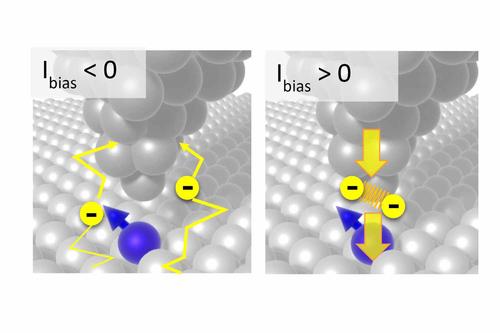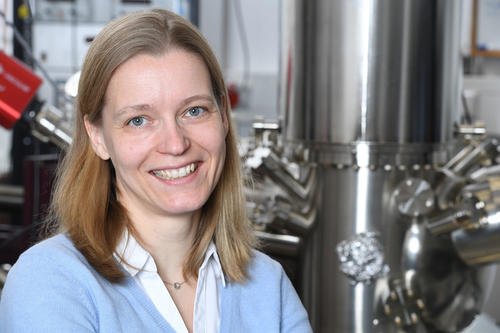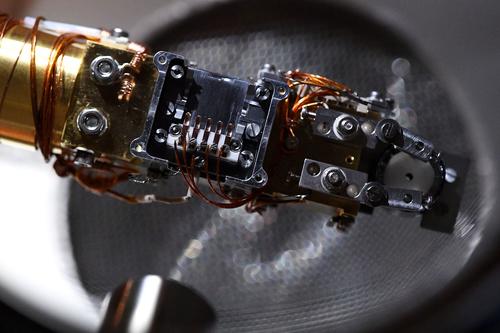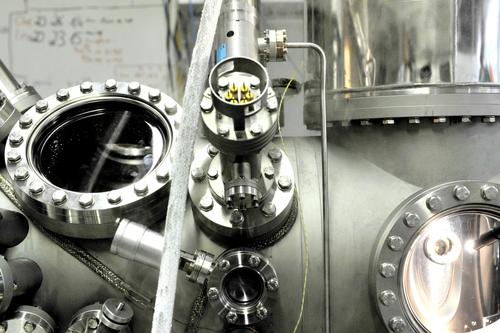Superconducting diode effect with a single magnetic atom
Superconducting diode effect with a single magnetic atom
Image Credit: Martina Trahms; AG Franke
Prof. Dr. Katharina Franke
Image Credit: David Ausserhofer
Prof. Felix von Oppen
Experimentaltechnik im Labor von Prof. Katharina Franke
Labor in der AG Franke
Superconducting diodes are regarded as promising future electronic devices. In a joint work, the groups of Katharina Franke and Felix von Oppen were able to realize a remarkably simple model system in which they could observe and explain the superconducting diode effect. The work was published in Nature.
News from Mar 15, 2023
All electronic devices contain components that favor current flow in one direction over the other. In conventional electronics, these so-called diodes consist of semiconductors. Researchers are currently investigating intensively whether it is possible to realize diodes made of superconducting materials. Superconductors allow current to flow without losses, i.e., without resistance. In superconducting diodes, currents of the same magnitude flow without loss in one direction, but are subject to resistance in the other. In the future, such devices could be used in virtually lossless superconducting electronics or could play an important role in controlling quantum bits, the elementary units of a quantum computer.
Superconducting diode effect in a conceptually simple system
Researchers at the Department of Physics of Freie Universität have now succeeded in observing the superconducting diode effect in a system, which is remarkably simple at the conceptual level. To this end, the experimental team led by Prof. Katharina Franke have realized tiny contacts made of the elementary superconductor lead (Pb). The diode effect occurred once a single magnetic atom was introduced into these contacts. The new diodes are interesting for several reasons. Due to the system’s conceptual simplicity, the microscopic origin of this diode effect could be explained in detail and traced to novel effects in cooperation with the theoretical research group of Prof. Felix von Oppen. Furthermore, the fact that the diode effect is induced by a single atom suggests that there are essentially no fundamental limits to miniaturizing superconducting diodes. The joint work of the two research groups was published in the renowned journal Nature.
The new superconducting diodes are based on the influence of a single magnetic atom on the supercurrent. Supercurrent, unlike ordinary electron current, is carried by electron pairs. These so-called Cooper pairs can conduct current without loss as they are coupled to each other in special ways. If two superconductors are brought in close proximity, Cooper pairs can tunnel from one superconductor into the other. This tunneling in superconducting contacts is a quantum mechanical effect known as the Josephson effect after its discoverer. For the contacts to remain superconducting, not only must they be very cold (below a material-specific critical temperature), but they must not be exposed to excessively large currents. If one slowly increases the current, at some point a "switching current" is reached at which the contact jumps from the superconducting to the normal, resistive state. If one subsequently reduces the current, the contact jumps back to the superconducting state at a certain “retrapping current”. However, the retrapping current is typically smaller than the switching current.
"The precise measurement of these currents poses the highest demands on the stability of the superconducting contacts. We create the contacts in a low-temperature scanning tunneling microscope by bringing a superconducting tip close to a superconducting surface," explains Martina Trahms, a doctoral student in Katharina Franke's research group. "Tip and surface have to be atomically clean, which is why we work under ultra-high vacuum conditions. We deposit a few magnetic atoms on the surface and selectively position the tip above one of these," she adds. "Martina surprisingly observed that the retrapping current into the superconducting state depends on the direction of the current flow when the contact includes a magnetic atom. This fascinating observation came completely unexpected to us," comments Katharina Franke.
An important clue to the origin of the effect was provided by measurements on two different magnetic atoms. It turns out that the diode effect has opposite asymmetry for manganese and chromium atoms, i.e., the supercurrent is more easily trapped in opposite directions. "Martina was already able to identify an experimental correlation of the retrapping current with the asymmetry of certain states induced in the superconductor by the magnetic atoms (so-called Yu-Shiba-Rusinov states)," says Katharina Franke, "but a precise understanding could only be obtained based on a microscopic theory developed by the group of Felix von Oppen."
New model accounts for the influence of magnetic atoms
"We first simulated the retrapping and switching currents starting from the asymmetry of the conductance that Martina had found in voltage-driven measurements on the individual atoms," explains Larissa Melischek. "We then set up a detailed model that took into account the influence of the magnetic atom and incorporated the essential conditions of the experiment," explains Jacob Steiner. Both are doctoral students in Felix von Oppen's group. With the help of this model, the asymmetry could be fully explained.
Based on the model, it became evident that this experiment and its explanation are fundamentally different from previous work on superconducting diodes. "Previously, it was assumed that time reversal invariance must be broken to observe diode behavior in superconductors," comments Felix von Oppen. "But that is not the case here. Instead, we find that the diode effect is due to the breaking of electron-hole symmetry by the magnetic atoms. Interestingly, this makes these superconducting diodes much more similar to conventional diodes. There is, so to speak, a 'real' diode integrated into the Josephson junction."
The results not only give hope for miniaturized superconducting diodes, but also open the door to many more experiments that examine the diode effect on the atomic scale. It will be interesting to see what the future holds.
Read the publication in Nature
Keywords
- Bharti Mahendru
- Cooper pairs
- diode effect
- electron hole symmetry
- Felix von Oppen
- Gaël Reecht
- Idan Tamir
- Jacob Steiner
- Josephson junctions
- Katharina Franke
- Larissa Melischek
- low-temperature scanning tunneling microscope
- Martina Trahms
- microscopic theory
- nature
- Nils Bogdanoff
- Olof Peters
- publication
- science
- single magnetic atom
- superconducting
- superconductor lead






